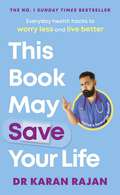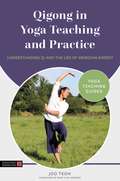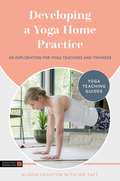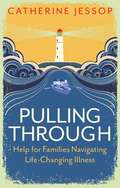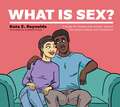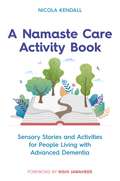- Table View
- List View
Yoga, Fascia, Anatomy and Movement, Second edition
by Joanne Avison"From Anatomy to Architecture, from Biomechanical to Biomotional and from Classical to Connected "- speaks to all bodies, in all modalities; in a world seeking unity and connection more than ever.Yoga, Fascia, Anatomy and Movement was written partly as an appeal for Yoga Teachers to appreciate the depth and breadth of Yoga as a science, a movement practice and a philosophy that fundamentally espouses "wholeness" as the basis of living anatomy and form. Yoga calls for unifying who and how we are; and as teachers - how we can help our clients (who are all different) move better.Classical Anatomy (in the West) divides the body down into its component parts and traditionally (unchanged for 400 years) reduces its functionality to those parts; usually described in a 2D iconic forms and founded in lever-based mechanics. In the East, such reductionism was never espoused and Yoga, Fascia, Anatomy and Movement covers two huge bases to bridge the difference and upgrade understanding of Yoga, to 21st Century anatomy:The first is to recognise that the leading edge of Fascia Science changes all those reductionist views (anatomically and biomechanically). It is carefully explained in the first part of the book and shows how the New Science of Body Architecture actually makes perfect sense of yogic philosophy of union and wholeness.The second is to take this paradigm shift and apply it in practice, to the subtle understanding of the fascial architecture and how that helps us move better. Yoga, Fascia, Anatomy and Movement attempts to ask questions, find suitable research and make all this practical and applicable to teachers and practitioners of all types. (Indeed, it teaches "posture profiling" and creating Class Mandalas, to support this). It is a contemporary yoga teacher's bible.
Supporting Yoga Students with Common Injuries and Conditions: A Handbook for Teachers and Trainees (Yoga Teaching Guides)
by Andrew McGonigleThis handbook guides yoga teachers and trainees in how to approach teaching students with common injuries and health conditions safely, confidently, and in a manner that empowers students.Dr Andrew McGonigle combines his medical background with extensive knowledge of yoga to address common injuries in detail with an in-depth review of anatomy. The book describes the psychology of pain and injury with reference to the latest research on pain and biomechanics. It also provides advice and tips on how to modify yoga techniques to suit the needs of students with injuries. Detailed illustrations throughout the book provide a visual guide to support understanding.This book is part of the series 'Yoga Teaching Guides', which provides expert information on essential topics as well as ideas for creative teaching.
Yoga Deconstructed®: Movement Science Principles for Teaching
by Trina AltmanMany people are drawn to a physical yoga practice as a way to reduce stress and move more. However, because most of their time is spent at a desk, their bodies are often not prepared to perform many of the traditional physical poses.Additionally, naturally flexible people will be drawn to the practice, because it comes easily to them. However, they frequently lack the stability needed to support their joints in these positions, which makes them vulnerable to pain and repetitive stress injuries.Yoga Deconstructed® offers the experience of yoga with an interdisciplinary approach that integrates other movement modalities and modern movement science. This approach helps students become more well-rounded in their movements, which better prepares them for asana and improves their ability to function in everyday life.This book teaches: How to help students move better and reduce their risk of injury within the scope of yoga, Pilates or any other movement modality. Regressions and progressions for human movement and yoga asana to fit the unique needs of the student. Critical thinking skills to help students safely transition from physical therapy to group classes. Strategies to introduce variability and neuromuscular re-education that help facilitate tissue resiliency, neuroplasticity, and new motor patterns. How to apply a skills-based approach, instead of a lineage-based approach Modern movement applications, including somatics, sensory feedback methods, and corrective exercise. How to deconstruct and expand yoga asana beyond static, two-dimensional shapes to reduce the risk of hypermobility and repetitive stress injuries.
The Feldenkrais Method: Learning Through Movement
by Staffan Elgelid Chrish KresgeThis book brings the Feldenkrais Method® and the concept of Somatic Education to a wide audience. As well as providing an introduction to the Feldenkrais Method® and its applications, a team of highly qualified contributors, representing a variety of therapeutic professions, explore how the Feldenkrais Method® interacts with and supports other professions and modalities, including Pilates, yoga, dance, physical therapy, sports coaching, rehabilitation medicine, and more. (See the table of contents for full details.)Moshe Feldenkrais (1904-1984), the founder of the Feldenkrais Method®, built his Method around the concept of improving human functioning by increasing self-awareness through movement. The concept of neuroplasticity - the brain's amazing capacity to change and adapt - was one of Feldenkrais' basic tenets of how the brain organizes movement, and is now in our daily lexicon. Pain, illness and injuries all affect how our nervous system and brain react to events in us and around us. Feldenkrais' thesis is that our nervous system always does the best it can with the information it has, and learning through the nervous system is the theme that runs through this book.Coverage includes:Comparisons about similarities as well as differences between the different modalities.Theory and practice of how the Feldenkrais Method® can be applied in a variety of specific settings.Coverage of the research base that supports evidence-informed practices for clientsOnline video of theory and practice accessed by QR codes throughout the book
The Asian Pantry: Quick & easy, everyday dishes using big Asian flavours
by Dominique WoolfDISCOVER ASIAN-INSPIRED RECIPES THAT ARE BIG ON FLAVOUR!Easy and delicious, umami-packed Asian inspired recipes all created using an accessible, affordable collection of essential pantry ingredients from the No. 1 Sunday Times bestselling author of Dominique's Kitchen---If you love Asian flavours and want simple, fuss-free cooking then this is the book for you.Your pantry, whether yours is a shelf, cupboard, drawer or even just a collection of bottles and jars on your kitchen worktop, is the key to cooking simple meals that are truly delicious.By using inexpensive store cupboard ingredients like soy sauce, curry powder, chilli flakes and noodles, Dominique Woolf shows you how to create flavour-packed, budget-friendly, Asian-inspired dishes all week long.Recipes include:· Sticky Orange Beef Noodles· Thai Green Curry Fried Rice· Korean Chicken & Kimchi Rice Traybake· Aromatic Coconut Salmon Curry· Vietnamese Cauliflower, Carrot & Potato Curry· Prawn & Chorizo Sweet Soy Noodles· Soy Sauce Chocolate Pots· Tamarind Toffee Apple PuddingWith over 80 recipes based around accessible ingredients that have bold flavour at their very heart, The Asian Pantry is your ultimate tool to creating Asian-inspired dishes the easy way from scratch at homePraise for Easy everyday Asian: 'A collection of fuss-free recipes that are packed full of flavour and goodness . . . We love the fusion of Thai and British food in many of these recipes' Evening Standard'One of the summer's hottest cookbooks' Daily Mail'Much tastier than a takeaway!' Woman
Deaf People and Society: Psychological, Sociological, and Educational Perspectives
by Irene W. Leigh Jean F. Andrews Cara A. Miller Ju-Lee A. WolseyDeaf People and Society is an authoritative text that emphasizes the complexities of being D/deaf, DeafBlind, Deaf-Disabled, or hard of hearing, drawing on perspectives from psychology, education, and sociology. This book also explores how the lives of these individuals are impacted by decisions made by professionals in clinics, schools, or other settings. This new edition offers insights on areas critical to Deaf Studies and Disability Studies, with particular emphasis on multiculturalism and multilingualism, as well as diversity, equity, and inclusion. Accessibly written, the chapters include objectives and suggested further reading that provides valuable leads and context. Additionally, these chapters have been thoroughly revised and incorporate a range of relevant topics including etiologies of deafness; cognition and communication; bilingual, bimodal, and monolingual approaches to language learning; childhood psychological issues; psychological and sociological viewpoints of deaf adults; the criminal justice system and deaf people; psychodynamics of interaction between deaf and hearing people; and future trends. The book also includes case studies covering hearing children of deaf adults, a young deaf adult with mental illness, and more.Written by a seasoned D/deaf/hard of hearing and hearing bilingual team, this unique text continues to be the go-to resource for students and future professionals interested in working with D/deaf, DeafBlind, and hard-of-hearing persons. Its contents will resonate with anyone interested in serving and enhancing their knowledge of their lived experiences of D/deaf, DeafBlind, Deaf-Disabled, and hard-of-hearing people and communities.
Trauma-Informed and Trauma-Responsive Yoga Teaching: A Universal Practice
by Catherine Cook-Cottone Joanne SpenceThis essential manual meets the increasing need for yoga teachers to be trauma-informed and trauma-responsive, and aware of how poses, breathwork, and meditation can impact the body. In detailing all aspects of trauma as it relates to yoga teaching, this guide lays a strong foundation in fostering trust and building authentic connections with students safely and confidently.Yoga teachers will benefit from a number of yoga practices for self-regulation, self-determination, and agency, as well as guidance on polyvagal theory, communication, setting boundaries, and yoga teacher self-care. It also includes a de-escalation protocol for in-session trauma responses and how to cultivate a trauma-informed teaching environment.Written by an internationally renowned author duo, this is a universal resource for yoga teachers looking to empower themselves and their clients from all demographics and in all settings.
Balanced Ligamentous Tension in Osteopathic Practice
by Susan TurnerThis user-friendly book will guide the reader to understand how balanced ligamentous tension (BLT) can be used as a therapeutic principle in the practice of osteopathy. The application of BLT is powerful, precise and specific but is also safe and comfortable for the patient and has been embraced with interest by osteopaths worldwide. BLT is seen by many as an indispensable bridge between the better known 'structural' and 'cranial' approaches and is an essential but almost forgotten part of the osteopathic heritage. In using 'the gentle exaggeration of the lesion', this approach is rooted in the original teaching of AT Still, osteopathy's founder, and that of his student W G Sutherland, who realised how potently the point of balanced tension can activate the innate self-correcting forces in the articular system. This teaching was passed on directly to the author by William Sutherland's close friend and student, Anne Wales D.O. As well as giving technical guidance and acting as a reference, citing relevant contemporary physiological research, this book is steeped in osteopathic philosophy. It seeks to enhance understanding of the reciprocal relationship between structural integrity and healthy function. By illustrating how the contact we make on the outside of the body influences the spatial environment of the physiology within, this highly effective approach can enable the practitioner to engage with the patient's potential for improved wellbeing and health.
Working with Unusual Essential Oils
by Helen Nagle-SmithAs the aromatherapy market expands exponentially, newer and lesser-known essential oils are often missed from traditional aromatherapy texts. This unique and updated toolkit profiles 40 emerging oils from around the globe with each profile detailing the background, strengths, chemistry, cautions and safety, sustainability, and personality of the essential oil. Each profile, including Moldavian dragonhead, petitgrain lemon, and damiana, also includes the physical, emotional, and spiritual uses of each essential oil as well as other oils with which it can be safely blended.Written by an experienced researcher and aromatherapist, this distinctive and comprehensive guide includes case studies and over 80 recipes, as well as the most up-to-date information on the latest recognised essential oils such as mango myrtle and pineapple myrtle.Aromatherapists reading this book will benefit from specialist knowledge on lesser-known and unusual oils, creating a more innovative and expansive practice.
This Book May Save Your Life: Everyday Health Hacks to Worry Less and Live Better
by Dr Karan RajanTHE #1 SUNDAY TIMES BESTSELLER'When you want to sort medical fact from medical fiction, Dr Karan is your man. This is the only book that will have you laughing and learning in equal measure' Dr Julie Smith, bestselling author of Why Has Nobody Told Me This Before'Wonderfully comforting' Chris van Tulleken, bestselling author of Ultra-Processed People'In a world of charlatans and social media snake-oil salesmen, [Dr Karan] provides a voice of reason...his health hacks may save your life' Mail on Sunday_______________________________The hilarious, myth-busting survival guide to the human body from TikTok's favourite General Surgeon.Though the odds are stacked against us, the human body has an extraordinary tendency to survive...Full of hard-learned lessons and health hacks from Dr Karan Rajan's years working the hospital wards, This Book May Save Your Life is a head-to-toe ode to our amazing bodies - warts and all - that will help you to worry less and live better for longer.Here, Dr Karan explains the weird and wonderful bodily functions that keep us going, and offers practical advice to help you thrive when things go wrong, including:THE DANGERS OF PLUCKING YOUR NOSE HAIRSYOUR UNTAPPED NATURAL REFLEXES TO COMBAT STRESSHOW TO MANAGE PAIN WITH SIMPLE MIND TRICKSAND WHY YOU SHOULD NEVER HOLD IN A FART_______________________________'I'll never look at my anus the same way' Hayley Morris, bestselling author of Me Vs Brain_______________________________PRAISE FOR DR KARAN RAJAN'The go-to expert for a generation' Telegraph'One of the few reliable social media experts' Daily Mail
The Alexander Technique: Twelve Fundamentals of Integrated Movement
by Penelope EastenOur entire human structure is built for movement, for all aspects of life. This book offers a new theoretical framework for understanding integrated movement, based on the latest scientific models and practical explorations.Presenting a new interpretation of how Alexander developed his work, Easten covers twelve fundamentals of movement and shows how optimal movement is organised around sensory and spatial awareness, and our focus and goals. The book describes how to reawaken innate balanced movement possibilities. Up-to-date scientific research is woven into Alexander's concepts to give a whole picture of how the human body feels, perceives, and self-organises. Clarifying the functional anatomy that underpins the Alexander technique, this book explains how to utilize the power of the autonomic nervous system and spatial awareness to allow us to change old harmful movement habits and enable new body learning.Written accessibly and supported by illustrations and video demonstrations of techniques, this book is ideal for Alexander technique teachers and trainees, movement educators and somatic therapists.
Yoga for Sports Performance: A Guide for Yoga Therapists, Yoga Teachers and Bodyworkers
by Jim HarringtonMany sports people are interested in trying yoga techniques in the hope of improved flexibility, strength, breathing and concentration, but many can be prevented from optimal results due to a lack of understanding on the part of yoga teachers of the specific physical requirements of their sport. This is a manual for professionals who work with athletes of all disciplines and shows them how to adapt yoga practice for swimmers, cyclists, runners, tennis players and more. This bridge between evidence-based modern sports medicine and the ancient practices of yoga, provides solid training guidance as well as offers psychological wisdom to help control and refine the actions of the mind. Essential reading for yoga therapists and teachers, athletic coaches and bodywork professionals who work with athletes.
Yoga Radicals: A Curated Set of Inspiring Stories from Pioneers in the Field
by Allie MiddletonConsisting of curated interviews with yoga pioneers including Gail Parker, Heather Mason and Neil Pearson, this book shows the transformational benefits of personal yoga practice and uncovers a collective deepening, resulting from accumulated practice and conscious application at scale. These interviews were collected with the 'presencing approach', used by the author in the dialogue and the interview process itself.The yoga narratives that form the heart of the book are inspirational stories from elders who have created transformational change in their own lives, or incorporated yoga into a bigger vision to benefit society and the planet. The book also presents a toolkit of actionable steps for readers to create social action and/or change.A unique example of moving from the 'me' consciousness to the 'we' consciousness, Yoga Radicals invites readers to join pioneers on a path of social action through personal transformation.
Qigong in Yoga Teaching and Practice: Understanding Qi and the Use of Meridian Energy (Yoga Teaching Guides)
by Joo TeohThis book inspires yoga teachers to explore the synergy between qigong and yoga sequencing through an exploration of how qigong principles, postures and themes can be incorporated into yoga. It allows yoga teachers to add a dimension of physical and energetic awareness during movement and in asana. Introducing key concepts, Joo Teoh demonstrates the application of each aspect as well as addressing variations and adaptations for different physical limitations. This book is also supported by black and white illustrations and photographs.This book is part of the series 'Yoga Teaching Guides', which provides expert information on essential topics as well as ideas for creative teaching.
Thai Massage Dissected
by Natasha de GrunwaldWritten by the UK's leading teacher and practitioner Natasha de Grunwald, a pioneer of Thai massage and bodywork for 30 years.Thai Massage Dissected is a book aimed at massage therapists, yoga teachers, physiotherapists, osteopaths and all manual therapists who want to expand their therapeutic approach and are curious to learn about the body from a Thai anatomy and dissection perspective.Therapeutic Thai massage and bodywork is a rich and diverse modality, so much more than the stretching and deep tissue work for which it is known. The book provides a richly curated combination of tools, techniques and protocols that will enhance all practitioners' skill sets. Natasha discusses the roots of this modality as Buddhist medicine, the five element system, the use of therapeutic herbs and Thai anatomy, whilst also writing about concepts such as proprioception and interoception. There is an additional chapter looking at traditional healthcare practices for women, informed by her time spent with village midwives on the Thai/Burmese border.Natasha de Grunwald uses imagery from many hours spent in a cadaver lab to describe anatomical, textural layers and structures, bringing human form to life.She consolidates this with a therapeutic perspective on Thai medical theory and how Thai massage and bodywork can be carried out in a clinical setting. This comes from her extensive research, studies and knowledge spanning over three decades.
Can I Have Babies Too?: Sexuality and Relationships Education for Children from Infancy up to Age 11
by Clare Bennett Sanderijn van der Doef Arris LueksDrawing on extensive professional and personal experience, this book offers guidance and advice on how to better communicate with children about relationships and sexuality using everyday situations. An invaluable resource for teachers and parents, it provides you with the tools you need to feel confident and informed about how to talk about sexual education at all stages. The book explores the challenges in adult-child communication about sexuality and provides helpful advice on how to establish an open dialogue. The guidance provided is developmentally appropriate, with chapters moving through different ages and development stages. Throughout, the book emphasizes the importance of positive sexuality education, empowering children to enjoy their relationships and sexuality in a safe and healthy way.
Head and Heart: Yoga therapy and art therapy interventions for mental health
by Ellen HorovitzEnvisioned as a resource for yoga teachers and all mental health and health professionals, Head and Heart is intended for:all health professionals who focus on mental health and/or wellbeing and want to broaden their understanding of how yoga and creative art therapy interventions can influence mental health approaches, best practices, and efficacy of treatment those who assist the therapeutic /healing processes who aspire to incorporate both yoga and creative art therapy interventions into their practice yoga therapy practitioners/teachers and creative art therapists/teachers who wish to deepen their knowledge of integrating yoga and creative art approaches into yoga, mental health and well-being. Western psychological processes (compared to the Klesas, V?ittis, Kosas, Gu?as, Do?as, Nadi System, Cakras, and the Yamas and Niyamas) make this book accessible even to those unfamiliar with yogic philosophy and psychology. Clearing exercises, warm-up techniques, yogic breathing for mood management, modifications and sequencing of poses, assessments (for the mind and body), digital and telehealth applications, yoga prop usage, and co-morbid, clinical cases (children, adolescents and adults) are presented throughout as a guide for the reader.Practical reflection exercises are offered in the Introductory chapter and chapters 3-6. These suggested practices summarize and reiterate the clinical material for the reader, and afford expansion toward oneself and /or one's clinical caseload.No matter what form it takes to move towards a creative opening, the reader will find that this book will aid you in moving yourself and your patients into the exploration of art, yoga, and well-being. This interoceptive research (going within) facilitates an expansion towards self and others and ensures that expansion, whether making art, practising yoga or working with disease. May this book move you and your patients toward that trajectory of sattva and well-being.
Developing a Yoga Home Practice: An Exploration for Yoga Teachers and Trainees (Yoga Teaching Guides)
by Joe Taft Alison LeightonThis book is ideal for all yoga teachers and trainees looking to create a consistent and personal home yoga practice. Whether you're newly qualified and looking for ways to establish a home practice routine, or have been teaching for a long time and are in need of fresh inspiration, this book is packed with tried-and-tested advice.Alison Leighton and Joe Taft provide logical and practical guidance in how to successfully use a home environment as an effective platform for teaching. They also show how a deep engagement with your own practice can nurture understanding, creativity and intelligence to the benefit of your students. This book also coaches teachers and trainees to engage in rejuvenating exercises in order to avoid the burnout well-known to many yoga teachers.
Pulling Through: Help for Families Navigating Life-Changing Illness
by Catherine Jessop"And at that exact moment, the earth tipped, and we all slid into a parallel universe..."On Christmas Day 2016, the Jessops were just an ordinary family, but on Boxing Day, one near-death experience swept them all into the bewildering world of hospitals and serious illness, and their lives changed forever.Pulling Through is a handbook of everything Catherine has learned on their journey. It covers many practicalities, such as explaining hospital tests and scans, jargon-busting medical terms, finance, rehabilitation and more. But it also illuminates the emotional aspect of illness and how massively it affects family and friends. There are chapters on the power of nature, music, counselling, optimism and humour, and how to look after the mental health of both patient and carer. This is a book of hope, help and reassurance on every aspect of coping with life-changing illness in the family: the good, the bad, the funny, the sad, and the useful. If you, or someone you know, has a life-changing illness, then this book is here to help.
Trauma Healing in the Yoga Zone: A Guide for Mental Health Professionals, Yoga Therapists and Teachers
by Joann LutzTrauma Healing in the Yoga Zone describes an original model of "Nervous System Informed, Trauma-Sensitive Yoga," (NITYA), a synthesis of classical yoga, somatic psychotherapy, and neuroscience research. It is organized around the eight branches of Raja Yoga, and includes scripts for administering NITYA chair yoga postures, breathing practices, and yoga nidra (the yogic sleep). These can be used by helping professionals with all levels of familiarity with yoga.The book is needed for several reasons: for mental health professionals, it offers a comprehensive overview of yoga philosophy and practices, as well as yoga-based options for working with the client's embodied experience, a major element in trauma healing. For yoga professionals and practitioners, it provides insight into the natural integration of yoga with polyvagal theory and other current approaches in the field of somatic psychology. Both professions are currently being enriched by data from the field of neuropsychology that describes brain function, in real time, in various mental and emotional states. This data supports yoga's effectiveness in regulating the autonomic nervous system, a key to trauma recovery.
Why Dementia Makes Communication Difficult: A Guide to Better Outcomes
by Alison WraySelected for Reading Well for Dementia 2024: endorsed by health experts, charities and people affected by dementia.Dementia brings many challenges, not least its ability to disrupt effective communication. The quality of communication plays a major role in how well people living with a dementia manage. When communication doesn't work well, the complications of dementia are compounded.Rather than only offering tips on what to say and how to say it, this book explores the underlying motivations of communication, so we can better understand why we say what we do, why we say it the way we do, what can go wrong, and how attempts to fix things can go awry.As well as considering why communication goes wrong in day-to-day conversations, the chapters offer advice on dealing with awkward moments, the question of deception, and the things we can and can't control in dementia. Readers are asked to reflect on their own role, and how they can manage their own behaviours to avoid unintentionally blocking routes to productive communication.Including clear action points for carers, bystanders and people with a dementia diagnosis, this book shows how to approach communication to improve outcomes.
What Is Sex?: A Guide for People with Autism, Special Educational Needs and Disabilities (Healthy Loving, Healthy Living)
by Kate E. ReynoldsThis carefully written and illustrated book provides an explanation of sex for people with autism and special education needs and disabilities (SEND). It helps readers to understand the physical processes as well as important issues such as consent and sexual safety, helping them to develop positive relationships.Many people with autism and SEND have or will have intimate relationships. Often sex is alluded to, rather than being carefully explored. This can create confusion around consent, sexual health, and pregnancy, and cause people to turn to dubious online information. This book frankly explains sex so that the reader has a clear understanding of what constitutes sex, knowledge of the proper names for sexual organs and sexual activities, and is aware of the potential physical consequences of having sex.
Spiral Bound: Integrated Anatomy for Yoga
by Karen KirknessSpiral Bound explores the potential for yoga as a healing modality by examining the body's anatomical structure as it has evolved embryonically. With a light touch approach, Karen weaves together threads of development to see how our morphological constraints arise in the earliest moments of life and how this rotation lays the spiral groundwork for rotational kinematics that encompass all tissue. This book sets out to link theory with practice, all at a conversational level richly illustrated with full-color photographs and drawings that bring the biomotion to life for practitioners and teachers of yoga. This book for anyone seeking to simplify the parts-list pedagogy of classical anatomy with contemporary research in fascia literature for an integrated approach especially suitable to postural yoga.
A Namaste Care Activity Book: Sensory Stories and Activities for People Living with Advanced Dementia
by Nicola KendallWith accessible resources and guidance, this book offers essential tools to support those living with advanced dementia through Namaste Care. Providing an overview of the approach, it draws on a range of professional expertise through contributory chapters on sensory activity and includes a variety of sensory stories and related activities.
Adapting Yoga for People Living with Cancer
by Jude MillsThis practical guidebook explains how to adapt physical poses and breathing exercises for people with cancer. Offering guidance on meditation and relaxation techniques as well as providing an essential overview of living with cancer, treatments and side effects, the book emphasises the importance of physical space and demonstrates the personal and professional skills required to hold a place of safety for those who experience life-threatening illnesses.Covering key topics such as scope of practice, boundaries and appropriate language, Adapting Yoga for People Living with Cancer is an essential guide for yoga teachers looking to hold cancer-inclusive classes.









